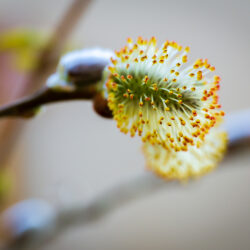Etymology
Salix is Latin for willow; discolor is Latin for not of the same color (referring to the deep green leaf surface and pale underside of this species)
Native Habitat
Wetlands, marsh edges and river bottoms.
Garden Uses
It is possible to maintain this shrub at a low height through annual pruning. Other than that occasional intervention, this is a low-maintenance plant with very few problems. It makes a great addition to a natural looking mixed hedge or rain garden.
Overview
Willows comprise North America’s largest genus of “tree-like plants.” Salix discolor is difficult to distinguish from several natural hybrids. Author of Flora Novae Angliae Arthur Haines calls Salix “a difficult genus,” and field guides caution against having confidence in identifying willows. These multi-trunked plants inhabit old fields and swamps, and are found along roadsides, wetland shorelines and in disturbed areas. Salix discolor is native to Maine and thrives in medium to wet soils and full sun to part shade; it performs best in full sun and moist soil where it can grow up to 15′ tall and spread about 12′ wide, although it will adapt well to dryer sites.
Leaves and Stems
The leaves are dark blue-green on the upper surface and lighter green on the underside. They are ½” – 1” wide and 1 – 4” long, oval, simple, and alternately arranged with tiny teeth along the edges. The stems are dark red-brown to yellow-brown and have bark that is gray-brown and smooth and becomes scaly as the plant ages.
Flowers
Buds and flowers emerge before the leaves in late winter and early spring. The fuzzy silver buds are called catkins. The flowers are unisexual with male and female flowers appearing in catkins on separate plants (dioecious).
Fruit/Seed
The female flowers mature as a capsule, usually with silky "cotton" to help transport the seeds by air.
Animal Associates
Willows provide a critical source of nectar and pollen in the early season for emerging insects such as small wasps, ants and bees and a variety of flies. Precocious nesters, especially our year-round northern residents like chickadees and American goldfinches, benefit from the multitude of insects found on the willows. Douglas Tallamy lists Willows as second only to Oaks in value as host plants for butterflies and moths. Among the many caterpillars found dining upon Salix discolor leaves are the larvae of Charismatic viceroy (Limenitis archippus) and Mourning cloak (Nymphalis antiopa) butterflies. Hairstreaks (Strymon spp.) Sphinx moths (Sphingidae) and Comma moths (Polygonia comma) are also supported by willows.
Propagation
Propagate willows by taking hardwood cuttings in early spring or by seed sown immediately after release from the plant.
Ethnobotanical Uses
The willow family is analgesic, anti-inflammatory, astringent and diuretic.
Sources
University of Maine Cooperative Extension
Douglas Tallamy. Bringing Nature Home: How You Can Sustain Wildlife with Native Plants, second edition. 2009
Plant Profile by Kathy Kling

